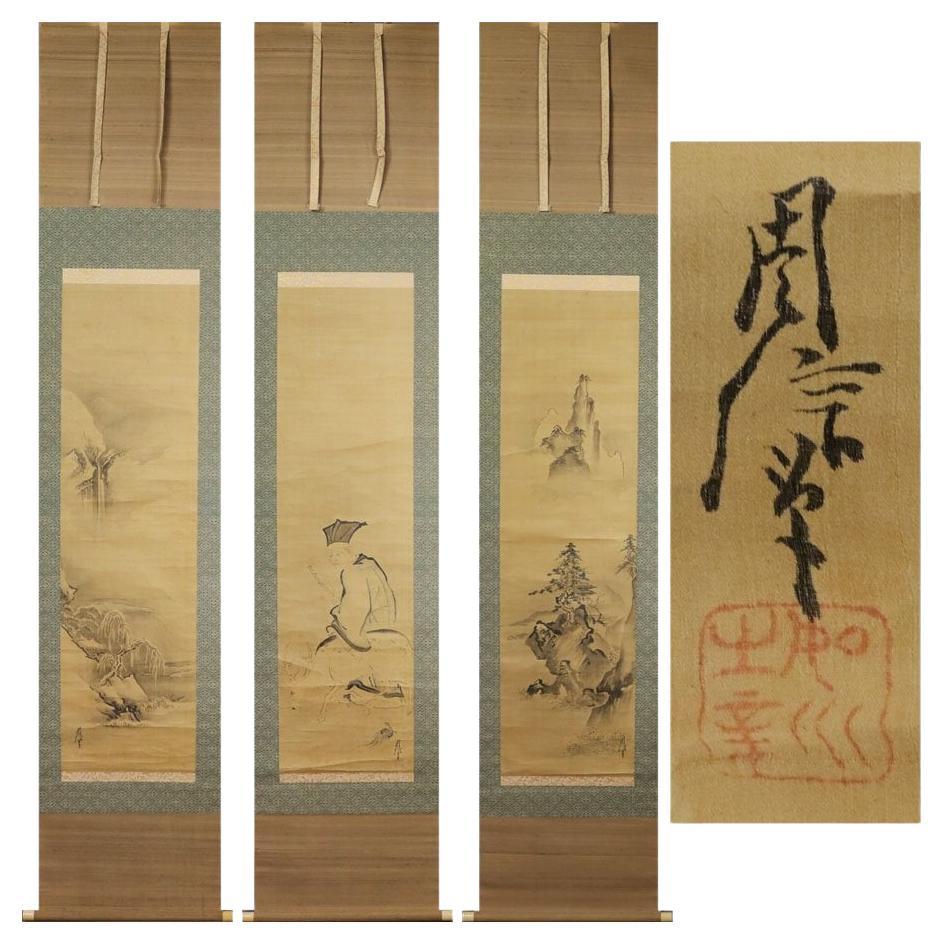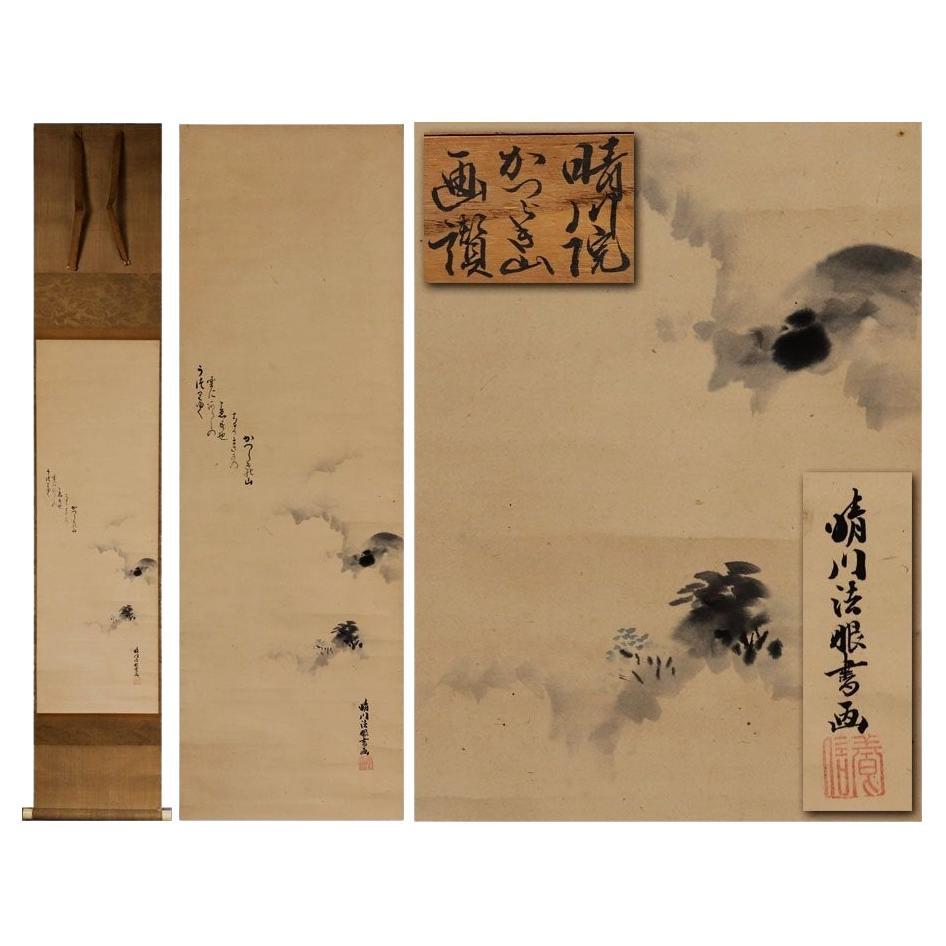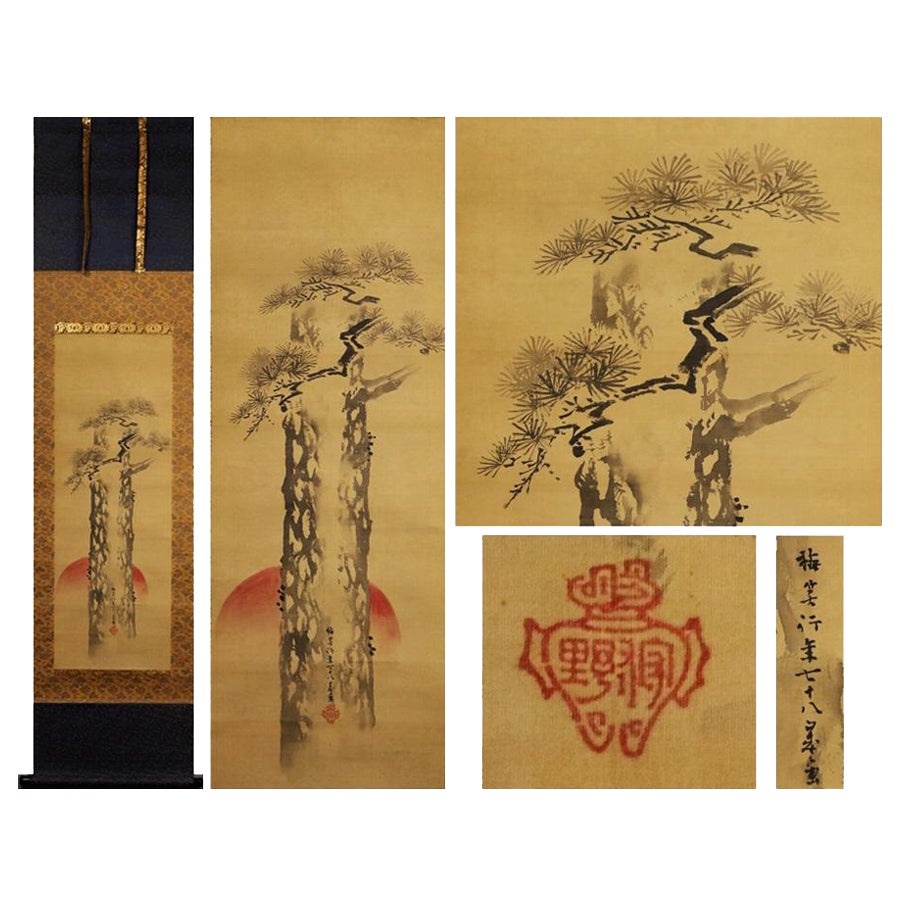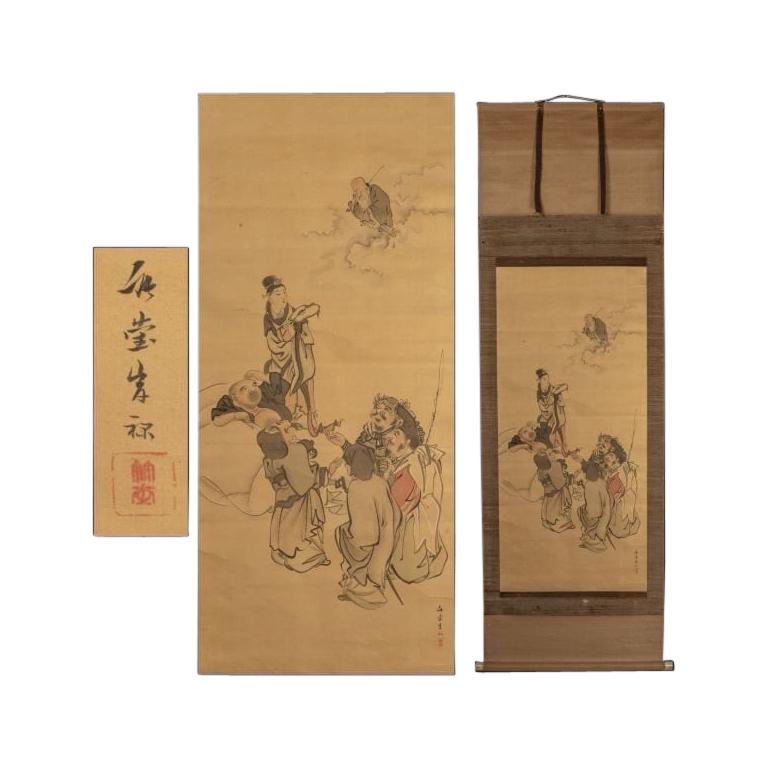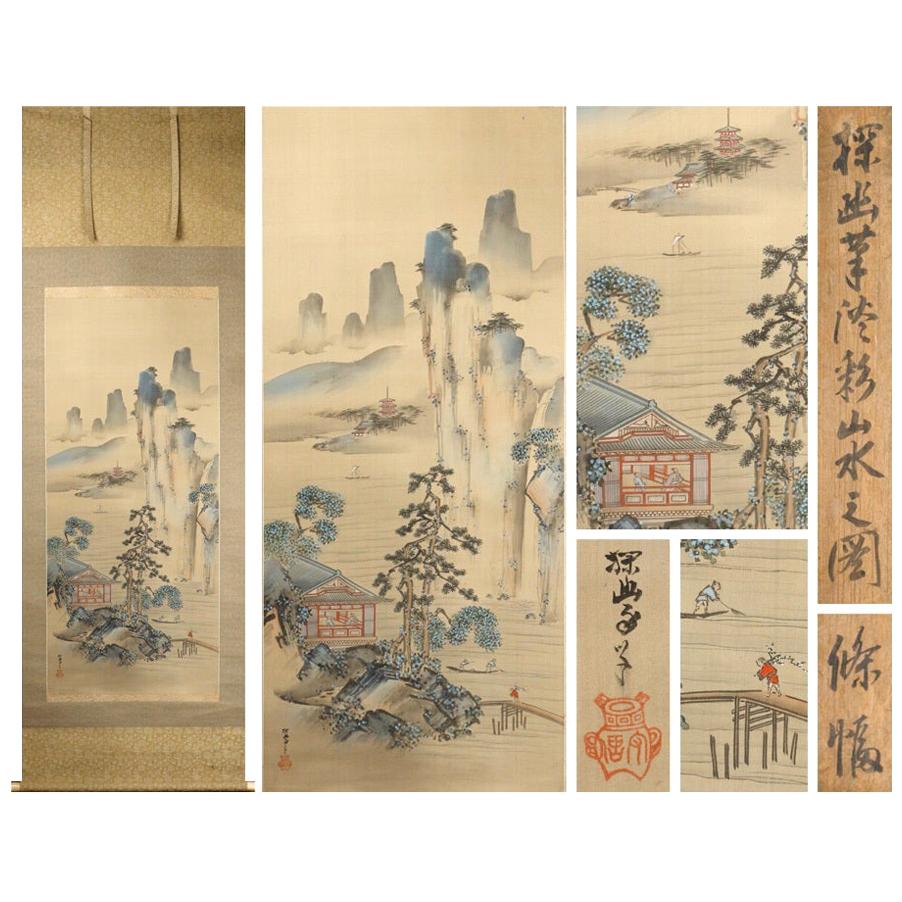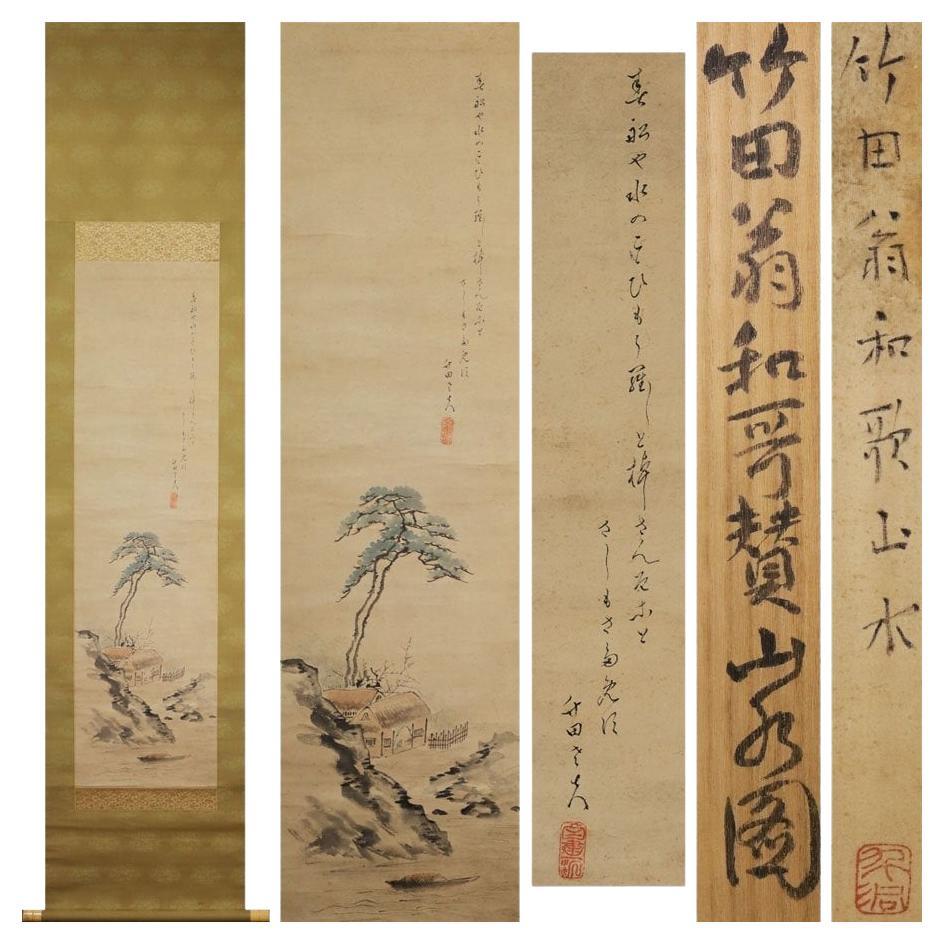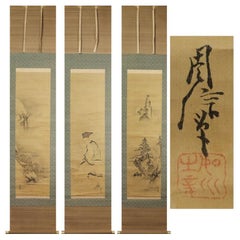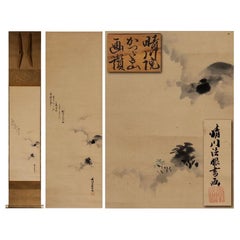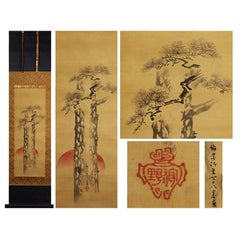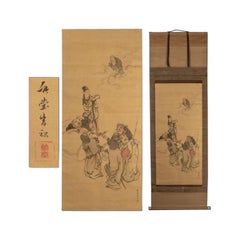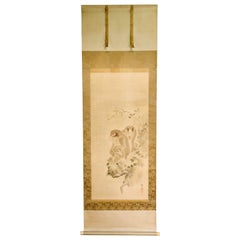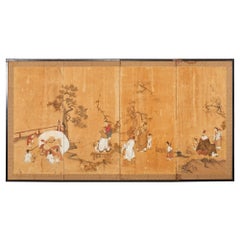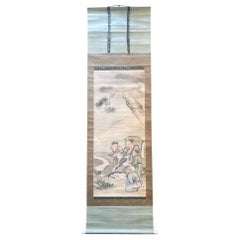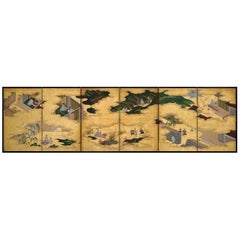Items Similar to Antique Japanese 17th c Edo Scroll Kano Yosanobu Buddhist Painting
Want more images or videos?
Request additional images or videos from the seller
1 of 7
Antique Japanese 17th c Edo Scroll Kano Yosanobu Buddhist Painting
$3,456.92
$4,321.1520% Off
£2,546.01
£3,182.5220% Off
€2,878.40
€3,59820% Off
CA$4,702.87
CA$5,878.5920% Off
A$5,225.92
A$6,532.4120% Off
CHF 2,738.44
CHF 3,423.0520% Off
MX$64,086.64
MX$80,108.3120% Off
NOK 34,927.20
NOK 43,65920% Off
SEK 32,858.23
SEK 41,072.7920% Off
DKK 21,912.82
DKK 27,391.0220% Off
Shipping
Retrieving quote...The 1stDibs Promise:
Authenticity Guarantee,
Money-Back Guarantee,
24-Hour Cancellation
About the Item
Eishin Kano's Ebisu/Great Country Map, double-width/comes with an old box.
The auspicious statues of Ebisu and Daikoku are standing in a double-width hanging scroll with a smiling face,
a figure that seems to ease the stiffness of the hearts of those who see it. In addition, the cover is also very elaborately constructed.
Kanō Yasunobu (狩野 安信, 10 January 1614 – 1 October 1685) was a Japanese painter of the Kanō school of painting during the Edo period. He was the third son of Kanō Takanobu, who had been head of the school, and succeeded Kanō Sadanobu as head of the Kyoto branch in 1623 until he joined his brothers in . Yasunobu was the youngest brother of Kanō Tan'yū, one of the most prominent painters of the Kanō school. His best remembered work is the Gadō Yōketsu, a Kanō school history and training manual. He also worked under the art names Eishin (永真) and Bokushinsai (牧心斎).
■Silk book, handpainted
■Condition:
There is discoloration due to the age.
■Dimensions
Axis dimensions/approx. 186.0cm x approx. 52.5cm.
Main paper dimensions: approx. 102.0cm x approx. 41.5cm.
■Inscription
There are inscriptions and inscriptions as shown.
■Box
Old box.
- Dimensions:Height: 73.23 in (186 cm)Width: 20.67 in (52.5 cm)Depth: 0.04 in (1 mm)
- Style:Edo (Of the Period)
- Materials and Techniques:
- Period:
- Date of Manufacture:1800
- Condition:Wear consistent with age and use.
- Seller Location:Amsterdam, NL
- Reference Number:Seller: 1801stDibs: LU4863236904452
About the Seller
5.0
Platinum Seller
Premium sellers with a 4.7+ rating and 24-hour response times
Established in 2015
1stDibs seller since 2019
264 sales on 1stDibs
Typical response time: 2 hours
- ShippingRetrieving quote...Shipping from: Amsterdam, Netherlands
- Return Policy
Authenticity Guarantee
In the unlikely event there’s an issue with an item’s authenticity, contact us within 1 year for a full refund. DetailsMoney-Back Guarantee
If your item is not as described, is damaged in transit, or does not arrive, contact us within 7 days for a full refund. Details24-Hour Cancellation
You have a 24-hour grace period in which to reconsider your purchase, with no questions asked.Vetted Professional Sellers
Our world-class sellers must adhere to strict standards for service and quality, maintaining the integrity of our listings.Price-Match Guarantee
If you find that a seller listed the same item for a lower price elsewhere, we’ll match it.Trusted Global Delivery
Our best-in-class carrier network provides specialized shipping options worldwide, including custom delivery.More From This Seller
View AllJapanese Painting 17th c Edo Scroll Triptyque Kano Chikanobu Buddhist Painting
Located in Amsterdam, Noord Holland
TheItem below was painted approximately 300 years ago by Kano Chikanobu. In the center is a depiction of a deer hermit, on the right is a landscape of a tower that gives a sense of ...
Category
Antique 17th Century Edo Paintings
Materials
Silk
$3,456 Sale Price
20% Off
Lovely Japanese 18/19th c Edo Scroll Kano Osanobu Nihonga Painting Mountain
Located in Amsterdam, Noord Holland
Kano Osanobu (狩野養信)
Osanobu Kano (born August 18, 1796; died June 12, 1846) was the ninth painter of the Kobikicho Kano School in the Edo period. His common name was Shozaburo. His father was Naganobu KANO, and Tadanobu KANO was his son. His Go (pen name) was Osanobu Seisenin, Kaishinsai, and Gyokusen.
Brief Personal History
He was born the eldest son of Naganobu ISENIN during the Edo period. He was first sent to serve at Edo Castle at the age of 15, and it appears that he was apparently pushed by his father to perform various public tasks for the Kanon School. He kept a diary for 36 years, starting from the day before he first went into service at Edo Castle until the day before he died. The diary is entitles "Official Service Diary" (it consists of 52 volumes that are maintained at the Tokyo National Museum, and 4 volumes that are separately maintained at the different families), and have become the focus of a lot of attention in recent years for the detailed information they present on the daily life and work of a prestigious official painter. The reading of the characters of his name was originally "Takenobu"; however, with the birth of the first son of the Shongun Ieyoshi TOKUGAWA in 1813, whose name was Takechiyo, having a sylable with the same pronunciation of "Take"was deemed to be inappropriate, and was therefore changed to "Osanobu". Because Takenobu died the following year, after which he was referred to as Gyokujuin, Osanobu changed his pen name Gyokusen he had used until that point to Seisenin, in order to avoid using the same Chinese charcter pronounced alike. In 1819, he attained the second highest rank for a Buddhist priest, Hogen, and assumed the role of head of the family after his father passed away in 1828. In 1834 he attained the highest rank for a Buddhist priest, Hoin. He oversaw the rennovation of the wall paintings of Nishinomaru Palace of Edo Castle from 1838 to 1839, and Honmaru Palace of it from 1844 to 1846. It is thought that Osanobu later died due to the fatigue...
Category
Antique 18th Century Edo Paintings
Materials
Silk
$1,727 Sale Price
20% Off
Antique Japanese 18th c Edo Scroll [Kano Baisho Nihonga Landscape Painting
Located in Amsterdam, Noord Holland
This is a ``Rising Sun and Pine Tree'' drawn by Kano Baisho.
It is an item with a solemn taste and presence, and I think it would be a good idea to display it at New Year's, the fir...
Category
Antique 18th Century Edo Paintings
Materials
Silk
$3,456 Sale Price
20% Off
Lovely Japanese 18th-19th Century Edo or Meiji Scroll Painting Seven Lucky God
Located in Amsterdam, Noord Holland
Interesting and finely painted Japanese painting.
Provenance: From an old family from Kyoto.
width of about 62.0 cm axial destination width of about 67.8 cm × length of about 1...
Category
20th Century Japanese Meiji Paintings and Screens
Materials
Bronze
$1,345 Sale Price
20% Off
Lovely 17th-18th Century Scroll Painting Japan Artist Kano Soyu Painted
Located in Amsterdam, Noord Holland
It is a work that is said to have been drawn by Kano Soyu as you can see.
It is a picture of the light-colored Sansui map carefully drawn to the smallest detail, and the
towering m...
Category
Antique 17th Century Japanese Edo Paintings and Screens
Materials
Silk
$3,026 Sale Price
20% Off
Japanese Nihonga Painting 18/19th c Edo Scroll Tanomura Chikuden Self Portrait
Located in Amsterdam, Noord Holland
Tanomura Takeda's handwritten self-portrait hymn "Painted Landscape" with himself working in a hut
Takeda Tanomura and depicts fields and mountains in spring, and is accompanied by a self-written waka poem that is thought to be about the scene.
[Tanomura Takeda]
A painter from Takeda Village, Naoniri District, Bungo Province (present-day Takeda City).
His family was born as the second son of Ken'an, who had been a samurai physician in the Oka domain for generations. He first studied medicine, but preferred learning over medicine, and studied Chinese studies under Kimizan Karahashi, a He also learned painting techniques from Buncho Tani, and after returning to Japan, he served as the president of a domain school.
He resigned his post in 1812 and traveled between Keihan and Osaka, where he interacted with Raizanyo, Shinozaki Kotake, Urakami Gyokudo, Okada Yonezanjin, Unka Shonin, Aoki Mokubei...
Category
Antique 18th Century Edo Paintings
Materials
Silk
$2,207 Sale Price
20% Off
You May Also Like
Japanese Silk Scroll Painting of Moneys Edo Period Mori Tetsuzan
Located in Atlanta, GA
A Japanese mounted vertical hanging scroll painting by Mori Tetsuzan (Japanese, 1775-1841) circa 19th century Edo period. The watercolor and ink on silk ...
Category
Antique 19th Century Japanese Japonisme Paintings and Screens
Materials
Silk, Paper
17th Century Japanese Edo Four Panel Screen Hotei with Chinese Sages
Located in Rio Vista, CA
Beautifully weathered late 17th/early 18th century Japanese edo period four panel byobu screen depicting hotei (fat monk) in a treed landscape with Chinese sages engaged in leisurely...
Category
Antique 17th Century Japanese Edo Paintings and Screens
Materials
Brass
Japanese Silk Scroll by Haruki Nanmei Edo Period
Located in Atlanta, GA
A Japanese hanging silk scroll by late Edo period painter Haruki Nanmei (1795-1878). The gouache painting was in the tradition of Kano school and depicts an old scholar dressed in lo...
Category
Antique 19th Century Japanese Edo Paintings and Screens
Materials
Silk, Paper
Japanese Screen Painting, Circa 1700 'Tales of Ise' by Tosa Mitsusuke
By Tosa Mitsusuke 1
Located in Kyoto, JP
A six-fold Japanese screen by Tosa Mitsusuke (1675-1710), Japan 17th-18th century, Edo period.
The signature reads Shoroku-i ge Tosa sa Konoe Shogen Mit...
Category
Antique Late 17th Century Japanese Edo Paintings and Screens
Materials
Gold Leaf
Large Antique Zen Japanese Ink Scroll After Sesson Shukei
Located in Atlanta, GA
A Japanese Sumi ink painting with light color wash mounted with brocade borders as a hanging scroll (Kakejiku). The painting depicts the famously eccentric Buddhist monks Hanshan and Shide (known in Japan as Kanzan and Jittoku). Often as a pair, they have been a popular motif in Japanese Zen painting...
Category
Antique 18th Century Japanese Japonisme Paintings and Screens
Materials
Silk, Paper
19th century Edo-period Japanese Hanging Scroll Calligraphy of Mad Poetry
Located in Chiba, JP
Hanging scroll with such unstrained and refined calligraphy of ‘Kyoka’ (lit. ‘Mad poetry’ – Humorous style of Japanese tanka poetry with joke or irony or satire) by a late Edo-period...
Category
Antique 19th Century Japanese Edo Antiquities
Materials
Brocade, Wood, Paper
More Ways To Browse
Japanese Wall Hanging
Japanese Hanging Scroll
Japanese Silk Wall Hanging
Kyoto Silk Painting
18th Century Japanese Silk Painting
Scroll Map
Japanese Scroll Kano
17th Century Kano
Antique Bird Nest Prints
Antique Egyptian Doors
Antique Freight Elevator
Antique Horse Ornament
Antique Rose Quartz
Antique Victorian Buttons
Bombay Chests
Bronze Thai Hand
Ceramic Hen
Champleve French Clocks
